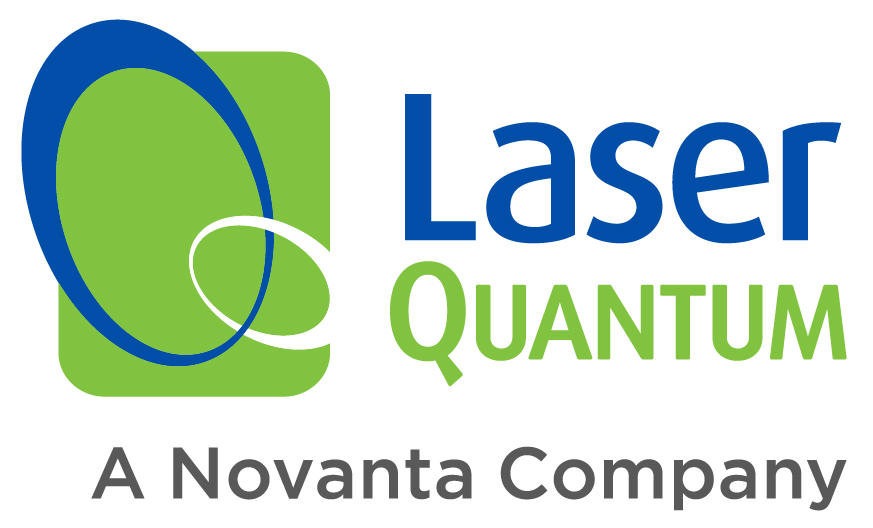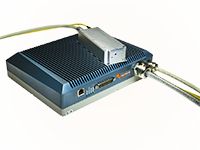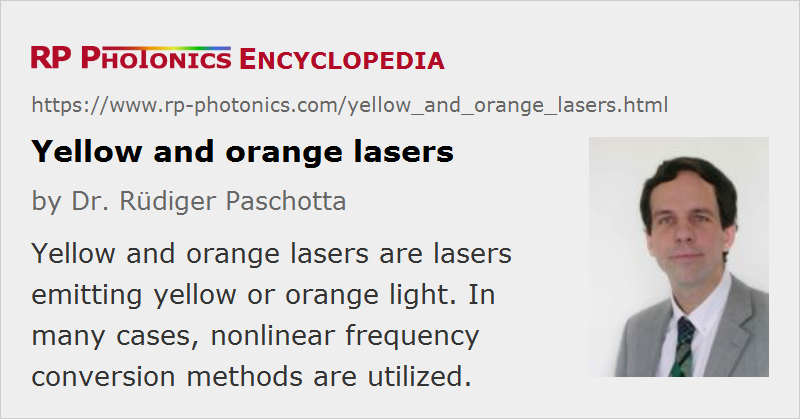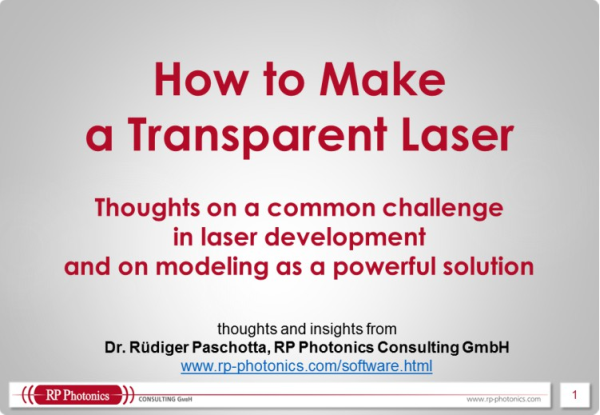Yellow and Orange Lasers
Definition: lasers emitting yellow or orange light
More general term: visible lasers
German: gelbe und orange Laser
How to cite the article; suggest additional literature
Author: Dr. Rüdiger Paschotta
This article discusses laser sources emitting in the yellow to orange spectral region, i.e. with a wavelength roughly around 570–625 nm. This spectral region is relatively difficult to access, at least when high output power, beam quality and power efficiency are required. Nevertheless, various types of yellow and orange laser sources exist:
- InGaP-based laser diodes may emit orange light e.g. around 610 nm [1]. The shorter the wavelength, the more difficult it is to obtain a good power efficiency and long lifetime.
- Praseodymium/ytterbium-doped upconversion lasers, e.g. based on fluoride fibers, can emit orange light with wavelengths around 605 nm [2].
- Dye lasers can cover the whole yellow–orange spectral region.
- Helium–neon lasers can utilize an orange laser transitions at 612 nm and 594.1 nm.
- Copper vapor lasers can emit pulses of yellow light at 578 nm [5].
- There are various types of frequency-doubled lasers, where the actual laser emits in the 1.1–1.2-μm spectral region and a frequency doubler converts this radiation into orange or yellow light. For example, a Cr4+:MgSiO4 (forsterite) laser can cover this spectral range [3]. There are also optically pumped semiconductor lasers (VECSELs) based on GaInNAs or InGaAs quantum wells, which can generate orange or yellow light via intracavity frequency doubling [7, 8].
- Some yellow or orange laser sources are based on sum frequency generation. For example, mixing the outputs of two Nd:YVO4 lasers emitting at 1064 nm and 1342 nm, respectively, results in orange light with 593.5 nm. There are even laser pointers containing such a source, but these are fairly expensive.
- Optical parametric oscillators may emit orange or yellow light, when pumped with a blue laser.
- There are Raman lasers, often based on Raman-active bulk crystals (e.g. tungstate crystals), which can either generate orange or yellow light from green pump light [4], or generate light with wavelengths around 1.1–1.2 μm with a 1-μm pump source [6], so that subsequent frequency doubling or sum frequency generation leads to orange or yellow light.
Orange and yellow laser sources are applied e.g. for laser guide stars (sodium laser beacons) and in medical laser therapies (e.g. photocoagulation in ophthalmology). Orange or even yellow laser pointers are not common.
Suppliers
The RP Photonics Buyer's Guide contains 37 suppliers for yellow and orange lasers. Among them:

Laser Quantum
Laser Quantum manufactures 561 nm yellow lasers used for biomedical imaging and cytometry. These applications require lasers that are both robust and reliable, whilst providing flexible control and high-quality beam characteristics.


Edmund Optics
Edmund Optics offers yellow and orange lasers in the form of solid-state lasers from the Coherent OBIS™ series.


Lumibird
The Lumibird CVFL-GIGA are frequency-converted ytterbium-doped fiber lasers emitting at a fixed design wavelength from 520 nm up to 590 nm.


TOPTICA Photonics
Latest developments in semiconductor amplifier and frequency-doubling technology expand the color and power spectrum of tunable diode lasers to more than 1000 mW at yellow and orange wavelengths. Applications such as laser cooling of sodium, dysprosium or erbium and spectroscopy of rare-earth ions in solids benefit from the compact and easy-to-handle laser systems. Lasers can be used also for a variety of applications to study objects ranging from nanometer scale, via micro- or macroscopic size, even towards galaxies and the universe. For example, artificial guide stars are required to optimize the spatial resolution of Earth-based telescopes. These artificial stars can be created using TOPTICA's guide star laser SodiumStar. This system has been decorated with the Berthold Leibinger innovation price for Laser Research in 2016.

RPMC Lasers
RPMC Lasers offers a wide range of yellow DPSS lasers between 560 nm and 589 nm. These offerings include CW and modulable lasers and modules with packaging at all levels of integration from OEM modules through turnkey system.


NKT Photonics
The Katana 06 HP is a high-power, yellow and orange, picosecond fiber laser. It delivers short pulses from 300 ps up to 10 ns in the spectral range 556–660 nm and up to 1 W average power. Its continuously tuneable repetition rate can be triggered from an internal or external source (master or slave operation), making synchronization to external equipment a breeze. Katana 06 HP is an alignment-free, industrial-grade laser module that opens the way to new developments in laser treatment and life science like fluorescence and STED microscopy, flow cytometry and photocoagulation.
Questions and Comments from Users
Here you can submit questions and comments. As far as they get accepted by the author, they will appear above this paragraph together with the author’s answer. The author will decide on acceptance based on certain criteria. Essentially, the issue must be of sufficiently broad interest.
Please do not enter personal data here; we would otherwise delete it soon. (See also our privacy declaration.) If you wish to receive personal feedback or consultancy from the author, please contact him e.g. via e-mail.
By submitting the information, you give your consent to the potential publication of your inputs on our website according to our rules. (If you later retract your consent, we will delete those inputs.) As your inputs are first reviewed by the author, they may be published with some delay.
Bibliography
| [1] | C. J. Nuese et al., “Orange laser emission and bright electroluminescence from In1−xGaxP vapor-grown p–n junctions”, Appl. Phys. Lett. 20, 431 (1972), doi:10.1063/1.1654004 |
| [2] | P. Xie and T. R. Gosnell, “Room-temperature upconversion fiber laser tunable in the red, orange, green, and blue spectral regions”, Opt. Lett. 20 (9), 1014 (1995), doi:10.1364/OL.20.001014 |
| [3] | A. Sennaroglu, “Broadly tunable continuous-wave orange-red source based on intracavity-doubled Cr4+:forsterite laser”, Appl. Opt. 41 (21), 4356 (2002), doi:10.1364/AO.41.004356 |
| [4] | R. P. Mildren et al., “Efficient, all-solid-state, Raman laser in the yellow, orange and red”, Opt. Express 12 (5), 785 (2004), doi:10.1364/OPEX.12.000785 |
| [5] | E. Le Guyadec et al., “A large volume copper vapor +HCl-H2 laser with a high average power”, IEEE J. Quantum Electron. 41 (6), 879 (2005), doi:10.1109/JQE.2005.846686 |
| [6] | R. P. Mildren et al., “Discretely tunable, all-solid-state laser in the green, yellow and red”, Opt. Lett. 30 (12), 1500 (2005), doi:10.1364/OL.30.001500 |
| [7] | J. Rautiainen et al., “2.7 W tunable orange-red GaInNAs semiconductor disk laser”, Opt. Express 15 (26), 18345 (2007), doi:10.1364/OE.15.018345 |
| [8] | M. Fallahi et al., “5-W yellow laser by intracavity frequency doubling of high-power vertical-external-cavity surface-emitting laser”, IEEE Photon. Technol. Lett. 20 (20), 1700 (2008), doi:10.1109/LPT.2008.2003413 |
| [9] | Z. Liu et al., “Self-frequency-doubled KTiOAsO4 Raman laser emitting at 573 nm”, Opt. Lett. 34 (14), 2183 (2009), doi:10.1364/OL.34.002183 |
| [10] | H. Zhu et al., “Yellow-light generation of 5.7 W by intracavity doubling self-Raman laser of YVO4/Nd:YVO4 composite”, Opt. Lett. 34 (18), 2763 (2009), doi:10.1364/OL.34.002763 |
| [11] | L. R. Taylor et al., “50 W CW visible laser source at 589 nm obtained via frequency doubling of three coherently combined narrow-band Raman fibre amplifiers”, Opt. Express 18 (8), 8540 (2010), doi:10.1364/OE.18.008540 |
| [12] | Z. Cong et al., “Theoretical and experimental study on the Nd:YAG/BaWO4/KTP yellow laser generating 8.3 W output power”, Opt. Express 18 (12), 12111 (2010), doi:10.1364/OE.18.012111 |
| [13] | J. Rautiainen et al., “2.5 W orange power by frequency conversion from a dual-gain quantum-dot disk laser”, Opt. Lett. 35 (12), 1935 (2010), doi:10.1364/OL.35.001935 |
| [14] | D. Pabœuf et al., “Diode-pumped Pr:BaY2F8 continuous-wave orange laser”, Opt. Lett. 36 (2), 280 (2011), doi:10.1364/OL.36.000280 |
| [15] | E. Kantola et al., “High-efficiency 20 W yellow VECSEL”, Opt. Express 22 (6), 6372 (2014), doi:10.1364/OE.22.006372 |
| [16] | B. Ernstberger et al., “Robust remote-pumping sodium laser for advanced LIDAR and guide star applications”, Proc. SPIE, 9641, 96410F (2015), doi:10.1117/12.2194874 |
| [17] | R. Bege et al., “Watt-level second-harmonic generation at 589 nm with a PPMgO:LN ridge waveguide crystal pumped by a DBR tapered diode laser”, Opt. Lett. 41 (7), 1530 (2016), doi:10.1364/OL.41.001530 |
See also: red lasers, green lasers, blue lasers, visible lasers
and other articles in the category lasers
 |






2020-03-15
I saw a yellow beam of light as large as a soccer ball coming from a window from the house across the street where i live. What could be happening there?
Answer from the author:
There are orange and yellow laser pointers, although they are not common. So I guess someone played around with such a device. Maybe the beam looked large due to the glare.